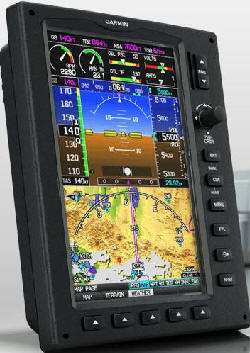
NEWSROOM
 |
NEWSROOM |
|
|
|
|
|||
|
By Mike Mitchell |
||||
 |
January 20, 2010 -
Garmin International Inc., today announced details for G3X engine
information system (EIS) and integrated autopilot interface. The EIS and
autopilot are designed specifically for the G3X and are an affordable
way for experimental and light sport aircraft (LSA) pilots to bring
Garmin integration and quality into their cockpit. The sensor kits are
expected to be available for all popular Lycoming, Continental, Rotax,
and Jabiru engines in February 2010.
The G3X is a non-TSO’d,
fully-customizable glass cockpit for installation in experimental
kitbuilt and LSA. This announcement was made in conjunction with the
U.S. Sport Aviation Expo in
|
|||
|
The G3X is a customizable PFD/MFD combination that features one, two or
three all-glass displays; magnetometer; ADAHRS (combined air data and
AHRS unit) and engine monitoring. Thanks to its building block design,
customers can create a high performance panel that is tailored to their
aircraft.
• RPM •
Manifold pressure |
||||
|
In addition to
gaining engine monitoring capabilities, G3X customers will also have the
benefit of an integrated autopilot interface that brings tried, tested
and proven G1000-like features to LSA and experimental aircraft owners.
Customers who select the TruTrak GX Pilot autopilot, which has been
designed to integrate seamlessly with the G3X, will enjoy advanced
autopilot features that can be operated right from the PFD. Using
controls and status indications derived from Garmin’s certified GFC 700,
the G3X autopilot interface implements sophisticated flight control
modes including altitude preselect and capture, heading hold, GPS
navigation with turn anticipation, and coupled VNAV descents. When used
in conjunction with a GNS 430W or 530W, the G3X can also fly coupled
holding patterns, procedure turns, and WAAS approaches. The basic G3X system is available at a starting street price of $9,995 and includes a GDU 370 glass display, GSU 73 ADAHRS and engine interface unit, GMU 44 magnetometer and GTP 59 air temperature probe. The G3X engine sensor kits for Lycoming, Continental, Rotax and Jabiru engines are sold separately. A software update that adds EIS and autopilot features is expected to be available for free in February 2010. |
| ©AvStop Online Magazine Contact Us Return To News |
|